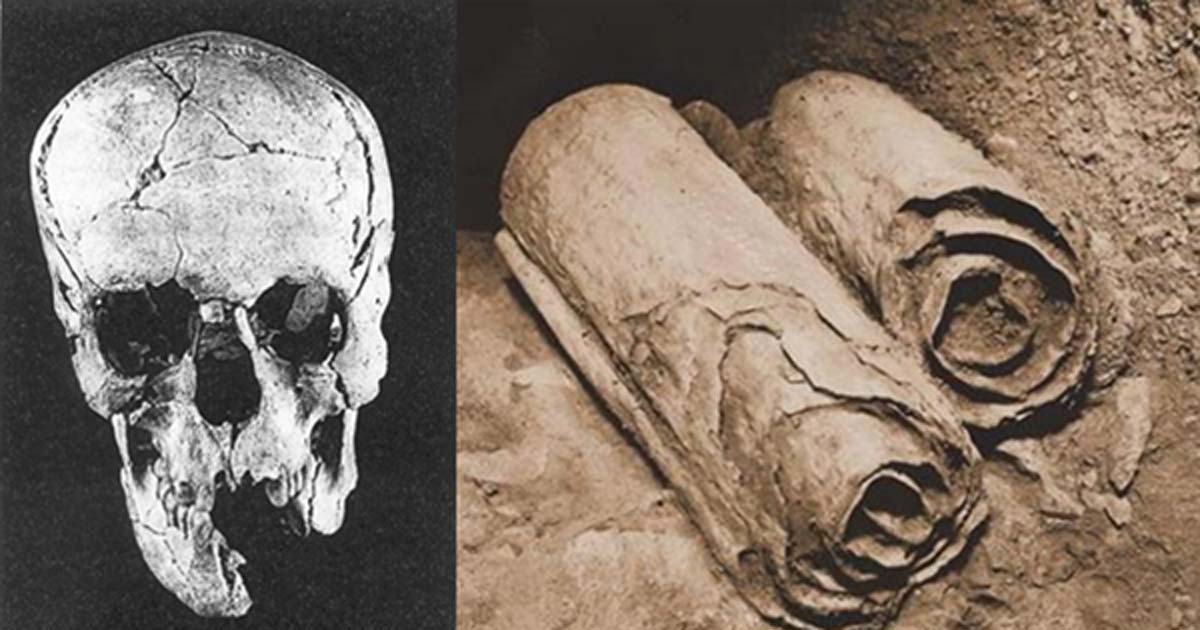Skeletons Found Near Dead Sea Scrolls Likely Belonged to an Enigmatic Religious Group
The discovery of the Dead Sea Scrolls is regarded as one of the greatest archaeological finds in history. Almost as interesting as the content of the texts themselves has been the question of who created and cared for them. A recent analysis of skeletons found near the site and dating to the same time period suggests the common assumption of an enigmatic religious group known as the Essenes may be correct.
The belief that people living in Qumran at the time of the Dead Sea Scrolls creation were members of a celibate Jewish sect called the Essenes is one of the earliest and also the most popular. These men were said to be the creators or caretakers of the famed scrolls. However, IBTimes notes Bedouin herders, craftsmen, and Roman soldiers have also been proposed as possible inhabitants of Qumran at that time.
ScienceNews reports that a recent evaluation of 33 skeletons buried at Qumran supports the popular belief that the community was comprised of religious men. The analysis focused on examining physical factors, including pelvic shape and body sizes, and concluded that it is highly probable only men and children were present at the site. Three of the skeletons could not be identified as male or female. This is a change from the previous assessment that seven of the skeletons were female.
- After 60 Years, Archaeologists are Thrilled to Find a Twelfth Dead Sea Scroll Cave
- Newly discovered ancient manuscripts from Dead Sea Scroll caves

Skulls found at Qumran. (Archaeology-of-Qumran/CC BY SA 3.0)
Radiocarbon dating of one of the Qumran skeleton’s bones places the body at approximately 2,200 years old. This is close to the time when the Dead Sea Scrolls are estimated to have been written - 150 BC to 70 AD.
The estimated age of death for the men ranged from around 20 to 50 years old. The lack of war-related injuries goes against the soldier hypothesis. Anthropologist Yossi Nagar of the Israel Antiquities Authority in Jerusalem said that the men cannot be confirmed as Essenes, but the belief is probable.

Section of the Qumran cemetery. (virtualqumran)
It is said the Essenes were an apocalyptic sect of Judaism that left Jerusalem in protest against the Romans and the way things were happening at the Temple. They apparently went into the desert to follow the orders of the prophet Isaiah. This religious group has often been linked to the Dead Sea Scrolls.
An excerpt of Nagar’s presentation at the 2017 annual meeting of the American Schools of Oriental Research states:
“The study proved the uniqueness of Qumran’s society, supporting the earliest theories which view Qumran as a community of ideologically celibate men. The new demographic results and interpretations are: infants and women are absent from the skeletal sample […] child proportion and adult age at death distribution match the common desert monasteric societies of the subsequent periods.”
Small samples of bone were removed from some of the Qumran skeletons, so there is a chance that researchers could try to complete DNA analysis and perhaps find more clear evidence of who the people living near the Dead Sea Scrolls were. However, Nagar is uncertain if this type of study will be completed.

Remains of living quarters at Qumran. (Public Domain)
The Dead Sea Scrolls were found in 11 caves at Qumran between 1947 and 1956. The set of nearly 1000 manuscripts provide some of the earliest versions of the Hebrew Bible. A 12th cave was discovered in February 2017, but only scroll jars, fragments of scroll wrappings, and a piece of worked leather were discovered.
- New Dead Sea Scrolls Discovered: Archaeologists Excited to Unearth Two New Fragments in the Cave of Skulls
- Dead Sea Scrolls Being Sold off to Private Buyers

View of the Dead Sea from a Cave at Qumran. (Public Domain)
The first Dead Sea Scrolls were found unintentionally by a Bedouin shepherd at a cave in the vicinity of Qumran. As more texts surfaced over the years, several were put on sale on the black market to private buyers. This issue led the Israel Antiquities Authority and the Heritage Project to excavate in the Judean Desert Caves in 2016 at the Cave of Skulls – a difficult location to reach. Israel Hasson, director-general of the Israel Antiquities Authority, explained the urgency to find the last Dead Sea Scrolls:
“For years now our most important heritage and cultural assets have been excavated illicitly and plundered in the Judean Desert caves for reasons of greed. The goal of the national plan that we are advancing is to excavate and find all of the scrolls that remain in the caves, once and for all, so that they will be rescued and preserved by the state.”

A fragment from the Dead Sea Scrolls collection known as the Damascus document. (Public Domain)
Top Image: A skull found at Qumran. (Archaeology-of-Qumran/CC BY SA 3.0) Two scrolls from the Dead Sea Scrolls lie at their location in the Qumran Caves before being removed for scholarly examination by archaeologists. (Public Domain)


















Comments
Someone should check out "Jesus and the Essenes" by Dolores Cannon. Take a look from another prospective, it could serve the community very well. I know it is hard for such learned people to think they could be unenlightened. It could have merit in looking at a subject from another point of view,, It makes the past come alive. Truth maybe, Facts maybe, maybe not but really interesting no less.